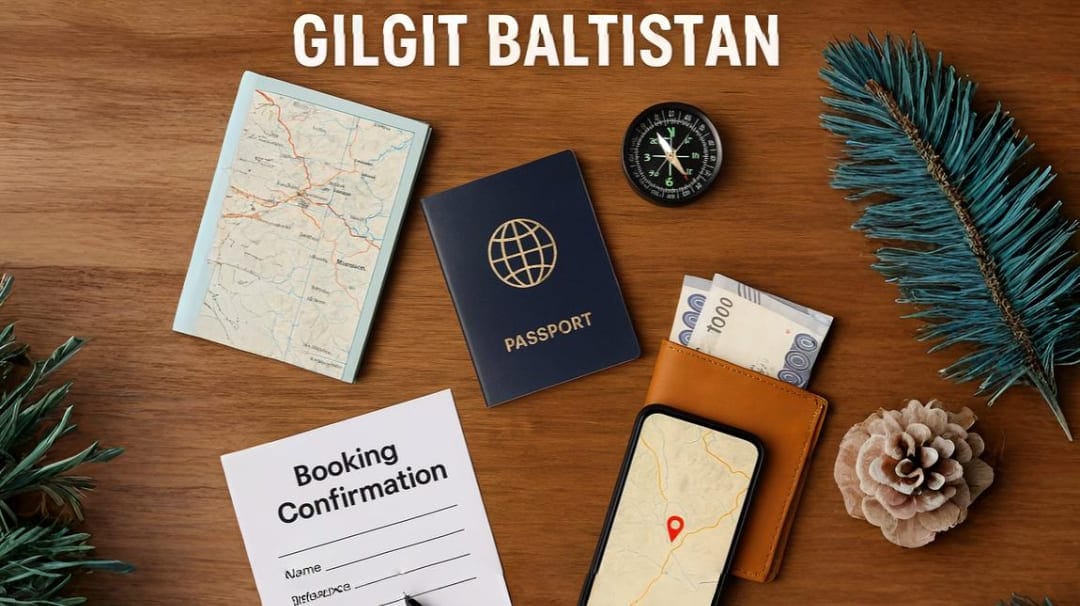Top 10 Travel Hacks and Tips in Gilgit Baltistan for an Unforgettable Trip:

Have you ever wondered how seasoned travelers breeze through the rugged beauty of Gilgit Baltistan with minimal fuss? Based on my experience traversing these mountains, a handful of insider tips can transform a “meh” trip into an unforgettable journey. In this post, you’ll discover 10 travel hacks and tips in Gilgit Baltistan that cover everything from packing smart to securing permits, saving you time, money, and stress. By the end, you’ll know exactly how to plan, pack, and experience this Himalayan gem like a pro. We’ll break it down into clear sections: best time to visit, packing essentials, local connectivity, budget tricks, and transport shortcuts.
With genuine travel hacks and tips in Gilgit Baltistan, you’ll be ahead of the crowd.
Hack 1: Pack Smart—Layer Up and Embrace Local Attire
- Why layers matter: Gilgit Baltistan’s weather can swing from frosty mornings (0-5 °C) to sunny afternoons (20-25 °C) in summer. A lightweight thermal base, fleece or down mid-layer, and a windproof shell will keep you comfortable year-round.
- Choose local wear: Locals wear a traditional shalwar kameez, which is significantly more comfortable than Western trousers at high altitudes. Pick one up in Gilgit for 1,500–2,500 PKR (≈ USD 9–15) or have it tailored for a perfect fit.
- Essential accessories: A scarf (to cover from wind or as a head covering), sunglasses with UV protection (sun glare off snow is intense), and a wide-brimmed hat are non-negotiable.
- Packing list infographic: Insert infographic showing “Gilgit Baltistan Packing Essentials” here.
Hack 2: Time Your Trip—Visit During Shoulder Seasons
- Peak season (June–August): Ideal for trekking and festivals, but prices spike and domestic tourists flood in.
- Shoulder season (September–October): Golden autumn foliage in Hunza and Skardu, pleasant weather, fewer crowds, and better rates—book accommodations early to lock in discounts.
- Winter travel (December–February): Roads may close due to snow, but if you’re prepared for cold (–5 °C to –15 °C) and want crisp, crowd-free landscapes, this is your hack—just verify flight schedules (Skardu often cancels due to snow) before you go.
Hack 3: Secure Reliable Connectivity—Choose the Right Network for Gilgit Baltistan
- Top Choice for Coverage:
SCOM (Special Communications Organization Mobile) remains the most dependable network across Gilgit Baltistan’s remote areas, especially in Hunza, Skardu, Astore, and valleys like Kharmang and Ghizer. As a regionally managed network, SCOM delivers stronger signals in off-grid destinations where other providers drop off completely. - Where to Get It:
You can purchase a SCOM SIM at the NLI Market franchise in Gilgit or at the Alamdar Chowk SCOM office in Skardu. Offices open around 8 AM, and registration typically takes 15–20 minutes with a passport copy or CNIC (if local). - Reliable Alternative – Zong 4G:
While SCOM leads in coverage, Zong has made solid improvements in larger towns and tourist hubs like Gilgit, Skardu city, and Hunza’s Karimabad. In these areas, Zong 4G sometimes offers better internet speeds than SCOM, especially for social media, video calls, and Google Maps. - When to Choose Zong:
If your travel is limited to urban zones and you prioritize 4G speed over rural reach, Zong is a viable choice. It’s also eSIM-enabled and compatible with most modern devices. - Pro Tip – Use Both for Best Results:
Carry both a SCOM and a Zong SIM if possible. This dual setup ensures strong backup coverage whether you’re trekking through valleys or uploading photos from a cozy Hunza café. - eSIM Option:
Prefer not to switch physical SIMs? Services like RoamEase and Airalo offer global eSIMs that may work in central GB cities—just download and activate before arrival to skip the local SIM registration queues.
Hack 4: Plan Your Permits & Local Passes in Advance
- NOC & special permits: Regions like Astore (Deosai Plateau) and Khunjerab Pass require permits—arrange through a local travel agent or the Gilgit-Baltistan Tourism Department at least 2–3 weeks before arrival.
- Cost-saving tip: If you’re travelling in a group (≥ 4), negotiate a group NOC fee discount (official cost ~ 7,000 PKR each) by showing you’ve pre-booked local accommodation and jeep hire. If you’re still wondering about things to do before visiting Gilgit Baltistan, securing all necessary NOCs and finding permits is definitely at the top of that list.
Hack 5: Navigate Transportation—Shared Jeeps & NATCO Buses
- Shared jeeps: For road trips from Gilgit → Hunza (Karimabad), shared jeeps depart when full (~ 5 people), costing ~ 300 PKR/person (versus private hire ~ 3,000 PKR).
- “Quick Checklist: Things to Do Before Visit Gilgit Baltistan”
– Confirm that your jeep or bus bookings are finalized.
– Print out e-tickets or booking references (It will be best if you travel through any travel agency in Gilgit Baltistan).
– Notify your bank about overseas ATM usage.” - NATCO VIP buses: If you prefer comfort for Gilgit → Skardu (19 hr drive), NATCO VIP buses (air-conditioned, reclining seats) run daily at 10 AM, costing ~ 2,300 PKR. Book 3–5 days in advance online to secure a roof-seat view of the Karakoram landscape (You can contact NorthernDiscover for easy booking).
- Booking platforms: Use Tikendis or BaltiBooking.pk (local ticket aggregators) for real-time seat availability and e-tickets, avoiding long queues at bus terminals.
Hack 6: Stay on Budget—Cash Is King & Local Homestays Save Big
- Carry sufficient cash: ATMs in Gilgit and Skardu dispense PKR only, and may run out of cash on weekends or during bank holidays—withdraw a 10,000–15,000 PKR buffer per leg of the trip.
- Homestay advantage: Many Hunza Valley families offer rooms (~ 1,500–2,500 PKR/night) with home-cooked meals (roti, apricot oil, local butter tea) included. Booking via GilgitBaltistanDiscoveries.com or contacting hosts on Facebook “Hunza Homestays” pages often yields 10–15% off published rates.
- Local markets: Buy dried fruits (apricots, mulberries) and must-have souvenirs from Gilgit Bazaar—negotiate down by starting 20% below sticker price, and walk away if they don’t budge. You’ll often find the same nuts/fabrics elsewhere 10–15% cheaper.
Hack 7: Acclimatize Gradually—Prevent Altitude Sickness
- First stop: Gilgit (1,500 m): Spend at least 1 night here to let your body adjust before climbing to Hunza (2,438 m) or Skardu (2,500 m).
- Hydration hack: Drink a minimum of 3 liters of water daily—carry a collapsible water bottle refillable at guesthouses to avoid single-use plastics.
- Local remedy: Sip green tea with honey and crushed fenugreek seeds (“methi”) each morning—locals swear by its acclimatization properties (balances electrolytes).
Hack 8: Embrace Slow Travel—Discover Hidden Gems
- Skip rushing to “must-see” attractions: Allocate an extra 1–2 days in Gojal Valley (Upper Hunza) to explore Attabad Lake’s ice caves by foot (instead of hiring a boat, which costs ~ 1,500 PKR/person).
- Local guide connect: Use Northerndiscover.com or PakistanTournTravel.com to book a community-registered guide (1,500 PKR/day) who shows you unmarked viewpoints (e.g., Shishkat Viewpoint over Indus Canyon).
- Afternoon explorations: After lunch (2–3 PM), local markets quiet down. Stroll **Gilgit’s Sunday Handicraft Bazaar (open Mon-Sat) early to snag artisanal wool shawls at 1,200–1,500 PKR instead of 2,000 PKR in peak hours.
Hack 9: Prioritize Safety—Stay Low Profile & Know Local Customs
- Gilgit Baltistan is generally safe, but petty theft or opportunistic scams can happen—hide valuables (passports, extra cash) in a hidden pouch or locked waist belt, and avoid flashing expensive cameras near remote villages.
- Dress conservatively: Both men and women should cover their shoulders and knees—carry a lightweight scarf to avoid unintentional disrespect in Shia and Ismaili communities.
- Local festivals: If you’re visiting during the Cherry Blossom Festival (April–May, Hunza) or the Shandur Polo Festival (July 7–9), book accommodation 2 months in advance—rooms sell out fast, and prices can spike 50–100%.
Hack 10: Capture & Share—Leverage Free Wi-Fi & Social Outreach
- Best free Wi-Fi spots: Many Karimabad cafés (e.g., Cafe de Hunza, Mountaintop Lodge) offer free Wi-Fi with a minimum purchase (≈ 200 PKR for tea/coffee). Upload early morning or late evening when speeds peak (~ 5-8 Mbps).
- Instagram-worthy angles: Snap Attabad Lake’s turquoise balloon glow at dawn (6–7 AM) for viral content—use hashtags #HunzaDiaries #GilgitBaltistan to tap into active travel communities and gain quick local followers.
- Engage local influencers: Tag @GilgitBaltistanPhotography or @HunzaLoversPK on your posts to get re-posted to 50K+ followers—this can spark collaborations (free homestays or guided hikes) if you have 2K+ engaged followers.
This final travel tip in Gilgit Baltistan ensures you leave no stone unturned.
Conclusion
In summary, these 10 travel hacks in Gilgit Baltistan equip you to travel smarter—packing light, syncing with local norms, staying connected, and uncovering hidden gems. By applying these tips, you’ll minimize stress (e.g., permit hassles, altitude sickness), stretch your budget, and maximize memories. And finally, don’t forget these last‐minute things to do before visit Gilgit Baltistan—like downloading offline maps and sharing your itinerary with a trusted local agent. Ready to experience GB like a local? Comment below with your favourite hack or share other tips you’ve discovered on your journeys through these majestic valleys.
